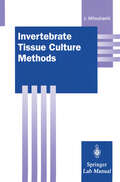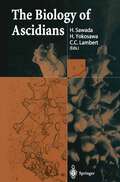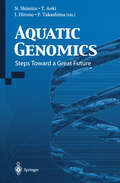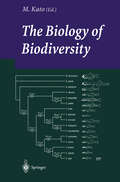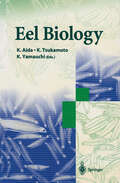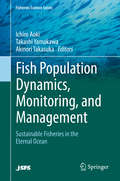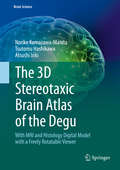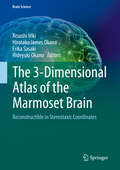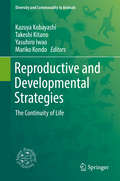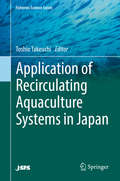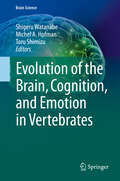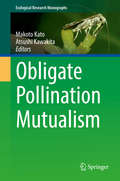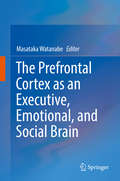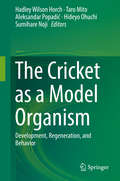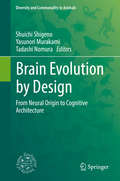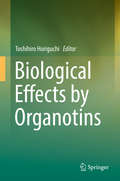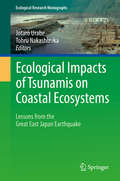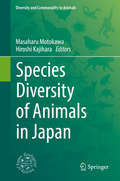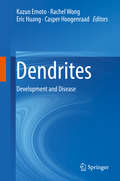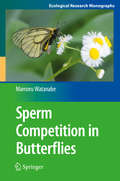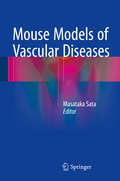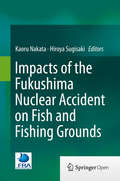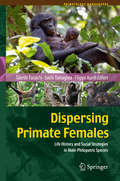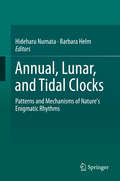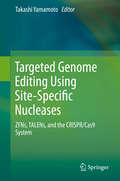- Table View
- List View
Invertebrate Tissue Culture Methods (Springer Lab Manuals)
by Jun MitsuhashiI started insect cell culture work in 1962, when T. D. C. Grace reported the first establishment of invertebrate continuous cell lines. He obtained grow ing cells from pupal ovaries of the emperor gum moth, Antheraea euca lypti. At that time, I was trying to obtain growing cells from leafhoppers. Grace's method could not be applied directly to my culture because of the differences in species, the size of the insects, and the tissue to be cul tured. The vertebrate tissue culture methods gave me some ideas for pre paring cultures from leafhoppers, but those could not be used directly either. There were no textbooks and no manuals for invertebrate tissue culture, so I had to develop a method by myself. First, I considered what type and what size of vessels are suitable for insect tissue culture. Also, I had to look for suitable materials to construct the culture vessels. Sec ond, I had to examine various culture media, especially growth-promot ing substances, such as sera. Then I had to improve culture media by trial and error. The procedure to set up a primary culture was also a problem. How could I sterilize materials? How could I remove tissues from a tiny insect? How many tissues should I pool in order to set up one culture? I had to find out the answers. Naturally, it took a lot of time.
The Biology of Ascidians
by H. Sawada H. Yokosawa C. C. LambertAscidians are the invertebrate group that gave rise to vertebrates, thus the biology of ascidians provides an essential key to understanding both invertebrates and vertebrates. This book is the first to cover all areas of ascidian biology, including development, evolution, biologically active substances, heavy metal accumulation, asexual reproduction, host-defense mechanisms, allorecognition mechanisms, comparative immunology, neuroscience, taxonomy, ecology, genome science, and food science. The 69 articles that make up the collection were contributed by leading ascidiologists from all over the world who participated in the First International Symposium on the Biology of Ascidians, held in June 2000 in Sapporo, Japan. For scientists and students alike, the book is an invaluable source of information from the latest, most comprehensive studies of ascidian biology.
Aquatic Genomics: Steps Toward a Great Future
by N. Shimizu T. Aoki I. Hirono F. TakashimaIn a scientific pursuit there is continual food for discovery and wonder. M. Shelley (1818) Genomic analysis of aquatic species has long been overshadowed by the superb activity of the human genome project. However, aquatic genomics is now in the limelight as evidenced by the recent accomplishment of fugu genome sequencing, which provided a significant foundation for comparative fish genomics. Undoubt edly, such progress will provide an exciting and unparalleled boost to our knowl edge of the genetics of aquatic species. Thus, aquatic genomics research has become a promising new research field with an impact on the fishery industry. It is notewor thy that the Food and Agriculture Organization (FAO) of the United Nations has projected that current global fisheries production will soon become insufficient to supply the increasing world population and that aquaculture has a great potential to fulfill that demand. This book, Aquatic Genomic. ~: Steps Toward a Great Future, was designed as a collection of advanced knowledge in aquatic genomics and biological sciences. It covers a variety of aquatic organisms including fish, crustaceans, and shellfish, and describes various advanced methodologies, including genome analysis, gene map ping, DNA markers, and EST analysis. Also included are discussions of many sub jects such as regulation of gene expression, stress and immune responses, sex differ entiation, hormonal control, and transgenic fishes.
The Biology of Biodiversity
by MasahiroKatoBiological diversity, or biodiversity, refers to the universal attribute of all living organisms that each individual being is unique - that is, no two organisms are identical. The biology of biodiversity must include all the aspects of evolutionary and ecological sciences analyzing the origin, changes, and maintenance of the di versity of living organisms. Today biodiversity, which benefits human life in vari ous ways, is threatened by the expansion of human activities. Biological research in biodiversity contributes not only to understanding biodiversity itself but also to its conservation and utilization. The Biology of Biodiversity was the specialty area of the 1998 International Prize for Biology. The International Prize for Biology was established in 1985 in commemoration of the sixty-year reign of the Emperor Showa and his longtime devotion to biological research. The 1998 Prize was awarded to Professor Otto Thomas Solbrig, Harvard University, one of the authors of this book. In conjunction with the awarding of the International Prize for Biology, the 14th International Symposium with the theme of The Biology of Biodiversity was held in Hayama on the 9th and 10th of December 1998, with financial support by an international symposium grant from the Ministry of Education, Science, Sports and Culture of Japan. The invited speakers were chosen so as to cover four basic aspects of biodiversity: species diversity and phylogeny, ecological biodiversity, development and evolution, and genetic diversity of living organisms including human beings.
Eel Biology
by K. Aida K. Tsukamoto K. YamauchiAs a food resource in both Eastern and Western countries, the eel is an important fish. Over the years, remarkable progress has been achieved in understanding the mysterious life cycle of eels that has fascinated scientists since the age of Aristotle. The spawning area of the Japanese eel was discovered and the migratory route of its larvae was elucidated. With the development of techniques for artificial induction of gonadal maturation, it became possible to obtain hatched larvae. Larval rearing to the leptocephalus stage, one of the most difficult tasks involved in eel culture, finally was achieved. By presenting these important breakthroughs, Eel Biology will be of great help in the development of effective management strategies for maintaining stable eel populations. With contributions by leading experts, this book is a valuable source for researchers as well as industry technicians in the fields of aquatic biology, aquaculture, and fisheries.
Fish Population Dynamics, Monitoring, and Management: Sustainable Fisheries in the Eternal Ocean (Fisheries Science Series)
by Ichiro Aoki Takashi Yamakawa Akinori TakasukaThis book explores how we can solve the urgent problem of optimizing the use of variable, uncertain but finite fisheries resources while maintaining sustainability from a marine-ecosystem conservation perspective. It offers readers a broad understanding of the current methods and theory for sustainable exploitation of fisheries resources, and introduces recent findings and technological developments. The book is divided into three parts: Part I discusses fish stock dynamics, and illustrates how ecological processes affecting life cycles and biological interactions in marine environments lead to fish stock variability in space and time in major fish groups; small pelagic fish, demersal fish and large predatory fish. These insights shed light on the mechanisms underlying the variability in fish stocks and form the essential biological basis for fisheries management. Part II addresses the technologies and systems that monitor changes in fisheries resources and marine ecosystems using two approaches: fishery-dependent and fishery-independent data. It also describes acoustic surveys and biological sampling, as well as stock assessment methods. Part III examines management models for effectively assessing the natural variability in fisheries resources. The authors explore ways of determining the allowable catch in response to changes in stock abundance and how to incorporate ecological processes and monitoring procedures into management models. This book offers readers a broad understanding of sustainable exploitation as well as insights into fisheries management for the next generation.
The 3D Stereotaxic Brain Atlas of the Degu: With MRI and Histology Digital Model with a Freely Rotatable Viewer (Brain Science)
by Noriko Kumazawa-Manita Tsutomu Hashikawa Atsushi IrikiThis book is the first digital atlas of the degu brain with microscopic features simultaneously in Nissl sections and magnetic resonance imaging (MRI). As an experimental animal model, the degu contributes to a variety of medical research fields in diabetes, hyperglycemia, pancreatic function, and adaptation to high altitude, among others. Recently the degu has gained increasing importance in the field of neuroscience, particularly in studies evaluating the relationship between sociality and cognitive brain functions, and in studies pertaining to the evolutional aspects of the acquisition of tool-use abilities. Furthermore, aging-related brain dysfunction in humans can be studied using this animal model in addition to mammals with much longer lifespans. This brain atlas is constructed to provide histological and volume-rendered information simultaneously, fitting with any spatial coordination in brain positioning. It can be a useful guide to degus as well as to other rodents for studies of brain structures conducted using MRI or other contemporary examination methods with volume-rendering functions.
The 3-Dimensional Atlas of the Marmoset Brain: Reconstructible In Stereotaxic Coordinates (Brain Science)
by Atsushi Iriki Hirotaka James Okano Erika Sasaki Hideyuki OkanoThis book provides accurate, comprehensive, and convenient reference for usages of the “freely rotatable three dimensional combined Nissl-stained and MRI digital data of the marmoset brain”. The key features of the original 3D digital data and of this atlas are: 1. The original digital datasets are freely rotatable in three dimensions, thus expected to be useful for any disciplines and anatomical interest, using any coordinate system, 2. Combined Nissl stained and MRI images are obtained from the same marmoset, to allow cross-modality matched references for multiple usages, 3. 86 Horizontal Series of Images with Neurosurgical Plane (based on the actual data), with more accuracy and resolution (Chapter 2) than the web-based digital images, 4. 32 Coronal Series of Images with Neurosurgical Plane (reproduced from the brain model) (Chapter 3), 5. 10 Parasagittal Series of Images with Neurosurgical Plane (reproduced from the brain model) (Chapter 4), 6. 3 Omnidirectionally Sliceable Planes (reproduced from the brain model) (Chapter 5), 7. In order to provide higher resolution structures to match systematic accuracy for supplementation of the digital data on the website, additional information are included. They are: 1) Nomenclature, 2) List of Brain Structures in Hierarchical Order, 3) Index of Abbreviations, together with 143 useful Bibliographic References list as of 2016, 8. Horsley-Clarke’s stereotaxic coordinates were adopted in the present atlas.
Reproductive and Developmental Strategies: The Continuity of Life (Diversity and Commonality in Animals)
by Kazuya Kobayashi Takeshi Kitano Yasuhiro Iwao Mariko KondoThis book provides new insights into the universality of biological systems in animal reproduction and development by a comparative study of a variety of mechanisms in animals ranging from basal invertebrates to vertebrates, including mammals.Animals accomplish genetic diversity through meiosis and fertilization, and during embryogenesis animals must produce specialized cell types, including germ cells, in accordance with their individual body plan. This series of phenomena is essential to the continuity of life in the animal kingdom, and animals show various reproductive and developmental strategies.This volume, comprising four parts, reviews animal kingdom diversity, including reproductive strategies and germ cell differentiation mechanisms (Part 1), sex determination and differentiation (Part2), the mechanisms of fertilization (Part 3), and body axis formation (Part 4). Readers will find descriptions of the reproduction or development of 180 species, 13 phyla, 35 classes, 74 orders, 117 families, and 151 genera in this book. Of particular interest is the diversity of molecules and mechanisms used to achieve the same biological purpose in different animals.Undergraduates, graduate students, and professional scientists who want a deeper understanding of animal reproductive and developmental mechanisms will find this book to be of great value.
Application of Recirculating Aquaculture Systems in Japan (Fisheries Science Series)
by Toshio TakeuchiThis is the first English book to address the current development of closed recirculating aquaculture systems (cRASs) in Japan, and its implications for industry in the near future. It offers an introduction to the topic and discusses the industrial application of cRASs. Around Europe, cRASs using freshwater have been developed, but to date there is little information about cRASs using the saltwater. As such, the book introduces the technical development of cRASs using the saltwater in Japan and describes measures necessary for their industrialization. It also discusses in detail various species, e.g., flounder, pejerrey, kuruma shrimp, white shrimp and abalone, which have been raised in cRASs. Furthermore, it presents wide topics concerning the technological development of aquariums, an area in which progressive Japanese techniques dominate. Lastly, the book also examines CERAS and poly-culture in Japan.The book is a valuable resource for a wide readership, such as local government officers, energy-industry staff, maintenance and system engineers, as well as those from the construction, agriculture and fishery industries.
Evolution of the Brain, Cognition, and Emotion in Vertebrates (Brain Science)
by Shigeru Watanabe Michel A Hofman Toru ShimizuThis book presents a new view on the evolution of the brain, cognition, and emotion. Around a half-century ago, Professor Harry Jerison published a seminal book entitled Evolution of the Brain and Intelligence. Since then, there has been a series of dramatic methodological and conceptual changes which have led to many new insights into the understanding of brain evolution and cognition. This book is particularly focused on three significant aspects of such changes. First, taking advantage of a new integrated approach called evolutionary developmental biology or Evo/Devo, researchers have started to look into vertebrate brain evolution from the developmental perspective. Second, comparative neuroanatomists have accumulated a large amount of information about the brains of diverse animal groups to refute the old-fashioned idea that vertebrate brains evolved linearly from non-mammals to mammals. Third, comparative behavioral studies have demonstrated that sophisticated cognition and emotion are not unique to some primates but are also found in many non-primate and even non-mammalian species. This work will appeal to a wide readership in such fields as neuroscience, cognitive science, and behavioral science.
Obligate Pollination Mutualism (Ecological Research Monographs)
by Makoto Kato Atsushi KawakitaThis book presents a comprehensive overview of our current understanding of mutualism origin, plant–pollinator specificity, mutualism stability, and reciprocal diversification. In particular, it focuses on the natural history and evolutionary history of the third example of obligate pollination mutualism, leafflower–leafflower moth association, which was discovered in the plant family Phyllanthaceae by the lead editor and then established by the editors and their coworkers as an ideal model system for studies of mutualism and the coevolutionary process. This work brings together the knowledge they have gained through an array of research conducted using different approaches, ranging from taxonomy, phylogenetics, ecology, and evolutionary biology to biogeography.Richly illustrated with numerous original color photographs, the volume consists of 13 chapters and is divided into three main parts: natural history, ecology, and evolution. It begins by showcasing numerous examples of plant–animal interactions and their origins to guide readers in the world of leafflowers and their pollinators. The immense diversity of Phyllanthaceae and pollinator moths is then explored, and in the following 7 chapters mutualism is discussed from a range of ecological and evolutionary points of view. The final chapter presents a review of the evolution and variety of obligate pollination mutualisms.This book offers researchers and students in the field of ecology, botany, evolutionary biology, pollination biology, entomology, and tropical biology fascinating insights into why such a costly pollination system has evolved and why Phyllanthaceae is so diverse despite the inconspicuousness of their flowers.
The Prefrontal Cortex as an Executive, Emotional, and Social Brain
by Masataka WatanabeThis book is devoted to the executive, emotional, social, and integrative functions of the prefrontal cortex (PFC). The PFC has usually been studied only with its executive function or with its emotional function, but recent studies indicate that the PFC plays important roles in integrating executive and emotional functions as well as in social behavior. The first part of the book reviews the functional organization of the PFC in human and nonhuman primates. The subsequent part focuses on the integrator of executive and emotional functions. The third part presents the integrator of executive and social functions, and the final part discusses the default mode of brain activities. There are chapters on animal studies, because functional significance of the PFC cannot be described without referring to those studies. Thus many methodologies are presented such as human neuropsychological, neuroimaging, and stimulation studies, and animal neuropsychological, neurophysiological, neurochemical, neuroanatomical, and neuroimaging studies. Bringing those together, this volume provides a timely and concise picture of the function of the PFC. The result is a valuable resource for students and scientists, providing up-to-date information on this emerging research topic.
The Cricket as a Model Organism: Development, Regeneration, and Behavior
by Hadley Wilson Horch Taro Mito Aleksandar Popadić Hideyo Ohuchi Sumihare NojiThis book covers a broad range of topics about the cricket from its development, regeneration, physiology, nervous system, and behavior with remarkable recent updates by adapting the new, sophisticated molecular techniques including RNAi and other genome editing methods. It also provides detailed protocols on an array of topics and for basic experiments on the cricket.While the cricket has been one of the best models for neuroethological studies over the past 60 years, it has now become the most important system for studying basal hemimetabolous insects. The studies of Gryllus and related species of cricket will yield insight into evolutionary features that are not evident in other insect model systems, which mainly focus on holometabolous insects such as Drosophila, Tribolium, and Bombyx. Research on crickets and grasshoppers will be important for the development of pest-control strategies, given that some of the most notorious pests also belong to the order Orthoptera. At the same time, crickets possess an enormously high “food conversion efficiency”, making them a potentially important food source for an ever-expanding human population.This volume provides a comprehensive source of information as well as potential new applications in pest management and food production of the cricket. It will inspire scientists in various disciplines to use the cricket model system to investigate interesting and innovative questions.
Brain Evolution by Design: From Neural Origin to Cognitive Architecture (Diversity and Commonality in Animals)
by Shuichi Shigeno Yasunori Murakami Tadashi NomuraThis book presents a new, detailed examination that explains how elegant brains have been shaped in evolution. It consists of 19 chapters written by academic professionals in neuroscience, opening with the origin of single-celled creatures and then introducing primordial types in invertebrates with the great abundance of the brains of vertebrates. Important topics are provided in a timely manner, because novel techniques emerged rapidly—as seen, for examples, in the next-generation sequencers and omics approaches. With the explosion of big data, neural-related genes and molecules is now on the radar. In fact, Europe’s big science and technology projects, a €1 billion plan called the Human Brain Project and the Blue Brain Project to understand mammalian brain networks, have been launched in recent years. Furthermore, with the rise of recently advanced artificial intelligence, there is great enthusiasm for understanding the evolution of neural networks. The views from brain evolution in nature provide an essential opportunity to generate ideas for novel neuron- and brain-inspired computation. The ambition behind this book is that it will stimulate young scientists who seek a deeper understanding in order to find the basic principles shaping brains that provided higher cognitive functions in the course of evolution.
Biological Effects by Organotins
by Toshihiro HoriguchiThis book provides an overview of the induction mechanism of imposex caused by organotin compounds in gastropods, as well as fundamental information on the physiology and biochemistry of reproduction in mollusks. Are the sex hormones of gastropod mollusks vertebrate-type steroids, or neuropeptides? What about lipid disturbance and membrane toxicity due to organotin compounds? The book also discusses the latest findings on the role of nuclear receptors, such as retinoid X receptor (RXR), retinoic acid receptor (RAR) and peroxisome proliferator-activated receptor (PPAR), in the development of imposex in gastropods. Further, it describes the current state of contamination by organotins in the marine environment and gastropod imposex, with a special focus on Europe and Asia, introduces readers to analytical techniques for organotin compounds, and assesses the contamination and adverse effects of alternatives to organotin-based antifouling paints. Imposex, a superimposition of male genital tracts, such as penis and vas deferens, on female gastropod mollusks, is known as a typical phenomenon or consequence of endocrine disruption in wildlife. Imposex is typically induced by very low concentrations of organotin compounds, such as tributyltin (TBT) and triphenyltin (TPhT) from antifouling paints on ships and fishing nets. Reproductive failure may be brought about in severely affected stages of imposex, resulting in population decline and/or mass extinction. Thus, gastropod imposex has been recognized as a critical environmental pollution issue. Although gastropod imposex is also highly interesting for the biological sciences because of its acquired pseudohermaphroditism and/or sex change by certain chemicals, such as TBT and TPhT, the mechanism that induces the development of imposex remains unclear, possibly due to our limited understanding of the endocrinology of gastropod mollusks. This book offers a useful guide for professionals and students interested in the fields of aquatic biology, invertebrate physiology, ecotoxicology and environmental science.
Ecological Impacts of Tsunamis on Coastal Ecosystems: Lessons from the Great East Japan Earthquake (Ecological Research Monographs)
by Jotaro Urabe Tohru NakashizukaThis book focuses on the ecological impacts of the Great East Japan Earthquake and resulting tsunamis, a rare and extremely large disturbance event, on various coastal ecosystems in Japan’s Tohoku area, including sub-tidal and tidal animal communities, sand dune plant communities and coastal forests. The studies presented here describe not only how species and populations in these ecosystems were disturbed by the earthquake and tsunamis, but also how the communities have responded to the event and what types of anthropogenic activities will hamper their recovery processes. In the ecological sciences, it is often argued that large disturbances are critical to shaping community structures and biodiversity in local and regional habitats. However, our understanding of these roles remains limited, simply because there have been few opportunities to examine and address the ecological impacts of large disturbance events. The scale of the 2011 Great East Japan Earthquake makes it one of the largest hazards in the past 1000 years. Thus, this book provides a unique opportunity to advance our understanding of the ecological impacts of large and rare disturbances and the implications of these events in the conservation and management of coastal ecosystems. Following an outline of the Great East Japan Earthquake, the book’s content is divided into two major parts. Part I reports on studies examining the ecological impacts of the tsunamis on sub-tidal and tidal animal communities, while Part II focuses on terrestrial plant communities in Japan’s coastal Tohoku area. This book will benefit all scientists interested in the ecological impacts of large disturbances on aquatic and terrestrial ecosystems in general, and especially those who are interested in the ecological management of coastal ecosystems and Ecosystem based Disaster Risk Reduction (EcoDRR).
Species Diversity of Animals in Japan (Diversity and Commonality in Animals)
by Masaharu Motokawa Hiroshi KajiharaThis book summarizes the status quo of the knowledge about the biodiversity in terrestrial, freshwater, and marine animals that live in Japan. Consisting of some 6,800 islands that are arrayed for approximately 3,500 km from north to south, the Japanese archipelago has a complex history in a paleogeographic formation process over time and harbors rich flora and fauna. This work will contribute to establishing a general biogeographic theory in archipelagoes around continental shelves.Facing the ongoing extinction crisis, one of the most important tasks for our generation is to bequeath this precious natural heritage to future generations. As the first step toward this goal, a species list has been compiled through solid, steady alpha-taxonomic work in each taxon. Furthermore, the phylogeography and population genetic structure for each species is elucidated for deeper understanding of the local fauna, the scientific results of which should be the basis for establishing conservation policies and strategies. Also the problem of alien or introduced species is investigated as another threat to the native fauna.Each of the 27 chapters is written by the most active specialist leading the field, thus readers can acquire up-to-date knowledge of the animal species diversity and their formation process of Japanese animals in the most comprehensive form available. This book is recommended for researchers and students who are interested in species diversity, biogeography, and phylogeography.
Dendrites: Development and Disease
by Kazuo Emoto Rachel Wong Eric Huang Casper HoogenraadStudies in human patients and animal models of disease suggest a strong correlation between defects in dendrite development and common neurological disorders such as autism. Much of this book is thus dedicated toward highlighting recent advances in our understanding of the cellular and molecular mechanisms that regulate the development and maintenance of dendrites, a crucial component of neurons. The book begins by presenting the current state of knowledge on the building blocks or cell biology of dendrites. Mechanisms that sculpt the stereotypic architecture of dendritic arbors and shape their connectivity are also discussed, along with recent work describing how dendritic organization and connectivity are perturbed in disease. A unique aspect of the book is its exploration of diverse neuronal cell types across vertebrates and invertebrates, allowing a comparison of mechanisms across distinct circuits and species. The book comprises six parts, which cover the major advances in the field: Part 1, Introduction; Part 2, Basic Biology of Dendrites; Part 3, Patterning Dendritic Architecture of Neurons and Their Populations; Part 4, Cellular and Molecular Control of Dendrite Development and Maintenance; Part 5, Synapse Formation onto Dendrites; and Part 6, Dendrites in Disease. The book offers an excellent point of entry for students interested in neuroscience, as well as for clinicians.
Sperm Competition in Butterflies (Ecological Research Monographs)
by Mamoru WatanabeThis book describes about 30 years of theoretical, empirical, and experimental work on butterfly sperm competition. It considers the reproductive morphology and sperm utilisation interests of males and females, which shape the mating tactics of each sex. Females of most butterfly species mate multiple times throughout their lives. The reasons are explored, as well as the numerous adaptations males have developed to prevent future mating and fertilisation by the sperm of other males. In particular, this volume focuses on the role of apyrene sperm. Eupyrene and apyrene sperm dimorphism is most likely a key factor in sperm competition, and the study in butterflies promotes understanding of sexual selection across animal species with sperm polymorphism. This book, describing the evolutionary causes and consequences of the sperm competition in butterflies, is a recommended read for students of behavioural ecology.
Mouse Models of Vascular Diseases
by Masataka SataThis book is a methodological source on mice models of vascular diseases. Covering various areas, each chapter is written by a pioneering researcher who has developed an original vascular disease model. Notoriously difficult to reproduce, each model is described in detail and numerous photographs are provided with links to videos. Genetically modified mice are a very powerful tool for studying the pathogenesis of various diseases, including immunological and oncological disorders, but they had always been thought to be too small to be used in the field of cardiovascular disease. Recently, however, various mice models of vascular diseases have been reported, and these will make a substantial contribution to basic research on cardiovascular and metabolic disorders.
Impacts of the Fukushima Nuclear Accident on Fish and Fishing Grounds
by Kaoru Nakata Hiroya SugisakiThis book presents the results from the Japanese Fisheries Research Agency’s 3-year intensive monitoring of radionuclides in a variety of fish, plankton, benthos, and their living environments after the Fukushima Daiichi Nuclear Power Plant (FNPP) accident in March 2011. The book reveals the dynamics of contamination processes in marine and freshwater fish, mediated by the contamination of water, sediments, and food organisms; it also clarifies the mechanisms by which large variations in the level of contamination occurs among individual fish. Most importantly, the book includes a large amount of original measurement data collected in situ and for the first time assesses diffusion of radiocesium across the Pacific using both in situ data and a numerical simulation model. Also introduced are several new approaches to evaluate the impact of the release of radionuclides, including the measurement of radiation emission from an otolith section to identify the main period of contamination in fish. The FNPP accident represents a rare instance where the environmental radioactivity level was elevated steeply through atmospheric fallout and direct discharge of radioactive water into the sea over a short period of time. Replete with precise scientific data, this book will serve as an important resource for research in fields such as fishery science, oceanography, ecology, and environmentology, and also as a solid basis for protecting fisheries from damage resulting from harmful rumors among the general public.
Dispersing Primate Females: Life History and Social Strategies in Male-Philopatric Species (Primatology Monographs)
by Takeshi Furuichi Juichi Yamagiwa Filippo AureliWhy do females in male-philopatric species seem to show larger variation in their life history strategies than males in female-philopatric species? Why did females in human societies come to show enormous variation in the patterns of marriage, residence and mating activities?To tackle these important questions, this book presents the latest knowledge about the dispersing females in male-philopatric non-human primates and in human societies. The non-human primates that are covered include muriquis, spider monkeys, woolly monkeys, gorillas, chimpanzees, bonobos and some species of colobine monkeys. In these non-human primate species females typically leave their natal group before sexual maturation and start reproduction in other groups into which they immigrate. However, there is a large variation as some females may breed in their natal group with some risks of inbreeding with their male relatives and some females may associate with males of multiple groups at the same time after leaving their natal group. Such variation seems to provide better strategies for reproduction depending on local circumstances. Although knowledge about female dispersal patterns and life history is indispensable for understanding the dynamic structure of primate societies, it is still not known how females behave after leaving their natal groups, how many groups they visit before finally settling down and which kinds of groups they choose to immigrate into, due to the large variation and flexibility and the difficulty of tracking females after natal dispersal.To encourage further progress in this important field, this volume provides new insights on evolution of female dispersal by describing factors influencing variations in the dispersal pattern across primates and a hypothesis for the formation of human families from the perspectives of female life history. This book is recommended reading for researchers and students in primatology, anthropology, animal behavior and evolution and for anyone interested in primate societies and human evolution.
Annual, Lunar, and Tidal Clocks: Patterns and Mechanisms of Nature's Enigmatic Rhythms
by Hideharu Numata Barbara HelmThere is more to biological rhythms than circadian clocks. This book aims at promoting the exciting potential of a deeper understanding of circannual, circatidal, and circalunar clocks. It highlights new developments, summarizes existing knowledge, and integrates different perspectives with the tools and ideas of diverse fields of current biology.For predominantly pragmatic reasons, research in recent decades was mostly concerned with circadian clocks. Clocks on other timescales, however, have been largely neglected and therefore still appear "enigmatic". Thanks to the rapid development of methods in molecular biology as well as in ecology, we are now able to re-approach these clocks. Laboratories around the world are showing fresh interest and substantial progress is being made in many independent projects. The book's two sections address the moon-derived circatidal, circasemilunar, and lunar cycles on the one hand (10 chapters), and the sun-derived circannual cycles on the other (6 chapters). This work brings together authors with an expansive array of expertise and study systems, ranging from tidal cycles of marine invertebrates to annual cycles of birds and mammals, and from behavioral to genetic and epigenetic backgrounds. While great challenges remain to be mastered, the book aims at conveying the excitement of unraveling, broadly, the rhythms of life.
Targeted Genome Editing Using Site-Specific Nucleases: ZFNs, TALENs, and the CRISPR/Cas9 System
by Takashi YamamotoThis book serves as an introduction to targeted genome editing, beginning with the background of this rapidly developing field and methods for generation of engineered nucleases. Applications of genome editing tools are then described in detail, in iPS cells and diverse organisms such as mice, rats, marine invertebrates, fish, frogs, and plants. Tools that are mentioned include zinc finger nucleases (ZFNs), transcription activator-like effector nucleases (TALENs), and CRISPR/Cas9, all of which have received much attention in recent years as breakthrough technologies. Genome editing with engineered nucleases allows us to precisely change the target genome of living cells and is a powerful way to control functional genes. It is feasible in almost all organisms ranging from bacteria to plants and animals, as well as in cultured cells such as ES and iPS cells. Various genome modifications have proven successful, including gene knockout and knock-in experiments with targeting vectors and chromosomal editing. Genome editing technologies hold great promise for the future, for example in biomedical research, clinical medicine, and generation of crops and livestock with desirable traits. A wide range of readers will find this book interesting, and with its focus on applications in a variety of organisms and cells, the book will be valuable for life scientists in all fields.
